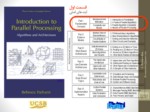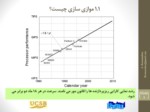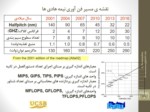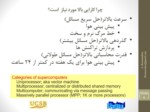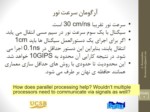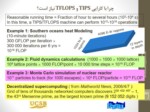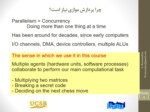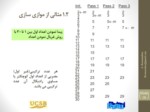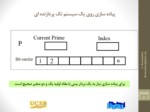بخشی از پاورپوینت
--- پاورپوینت شامل تصاویر میباشد ----
اسلاید 1 :
چرا کارایی بالا مورد نیاز است؟
- سرعت بالاتر(حل سریع مسائل)
- پیش بینی هوا
- خط مرگ نرم و سخت
- گذردهی بالاتر(حل مسائل بیشتر)
- پردازش تراکنش ها
- قدرت محاسباتی بالاتر(حل مسائل طولانی)
- پیش بینی هوا برای یک هفته در کمتر از 24 ساعت
اسلاید 2 :
آرگومان سرعت نور
- سرعت نور تقریبا 30 cm/ns است.
- سیگنال با یک سوم سرعت نور در سیم مسی انتقال می یابد.
- اگر برای اجرای یک دستورالعمل سیگنال ها باید 1cm انتقال یابند، بنابراین این دستور حداقل در 0.1ns اجرا می شود. در نتیجه کارایی آن محدود به 10GIPS خواهد شد.
- این محدودیت تا حدودی با روش های حداقل سازی معماری همانند حافظه ی نهان بر طرف می شود.
اسلاید 3 :
چرا پردازش موازی نیاز است؟
Parallelism = Concurrency
Doing more than one thing at a time
Has been around for decades, since early computers
I/O channels, DMA, device controllers, multiple ALUs
The sense in which we use it in this course
Multiple agents (hardware units, software processes) collaborate to perform our main computational task
- Multiplying two matrices
- Breaking a secret code
- Deciding on the next chess move
اسلاید 4 :
1.2 مثالی از موازی سازی
پیدا نمودن اعداد اول بین 1 تا 30 با روش غربال نمودن اعداد
هر عدد ترکیبی(غیر اول) مضربی از اعداد اول کوچکتر یا مساوی رادیکال آن عدد ترکیبی می باشد.
اسلاید 5 :
Status of Computing Power (circa 2000)
GFLOPS on desktop: Apple Macintosh, with G4 processor
TFLOPS in supercomputer center:
1152-processor IBM RS/6000 SP (switch-based network)
Cray T3E, torus-connected
PFLOPS on drawing board:
1M-processor IBM Blue Gene (2005?)
32 proc’s/chip, 64 chips/board, 8 boards/tower, 64 towers
Processor: 8 threads, on-chip memory, no data cache
Chip: defect-tolerant, row/column rings in a 6 ´ 6 array
Board: 8 ´ 8 chip grid organized as 4 ´ 4 ´ 4 cube
Tower: Boards linked to 4 neighbors in adjacent towers
System: 32´32´32 cube of chips, 1.5 MW (water-cooled)
اسلاید 6 :
1.5 Roadblocks to Parallel Processing
- Grosch’s law: Economy of scale applies, or power = cost2
- Minsky’s conjecture: Speedup tends to be proportional to log p
- Tyranny of IC technology: Uniprocessors suffice (x10 faster/5 yrs)
- Tyranny of vector supercomputers: Familiar programming model
- Software inertia: Billions of dollars investment in software
- Amdahl’s law: Unparallelizable code severely limits the speedup
اسلاید 7 :
اثر گذاری پردازش موازی
P تعداد پردازنده ها
W(p) کار انجام شده توسط p پردازنده
T(p) زمان اجرایی توسط p پردازنده
T(1) = W(1); T(p) £W(p)
S(p) = T(1) / T(p) افزایش سرعت
راندمان E(p) = T(1) / [p T(p)]
افزونگی R(p)= W(p) / W(1)
بکارگیری U(p) = W(p) / [p T(p)]
کیفیت Q(p)= T3(1) / [pT2(p) W(p)]
اسلاید 8 :
A Amdahl’s Law (Speedup Formula)
Bad news – Sequential overhead will kill you, because:
Speedup = T1/Tp £ 1/[f + (1 – f)/p] £ min(1/f, p)
Morale: For f = 0.1, speedup is at best 10, regardless of peak OPS.
B Brent’s Scheduling Theorem
Good news – Optimal scheduling is very difficult, but even a naive
scheduling algorithm can ensure:
T1/p £ Tp < T1/p + T¥ = (T1/p)[1 + p/(T1/T¥)]
Result: For a reasonably parallel task (large T1/T¥), or for a suitably
small p (say, p < T1/T¥), good speedup and efficiency are possible.
C Cost-Effectiveness Adage
Real news – The most cost-effective parallel solution may not be
the one with highest peak OPS (communication?), greatest speed-up
(at what cost?), or best utilization (hardware busy doing what?).
Analogy: Mass transit might be more cost-effective than private cars
even if it is slower and leads to many empty seats.

